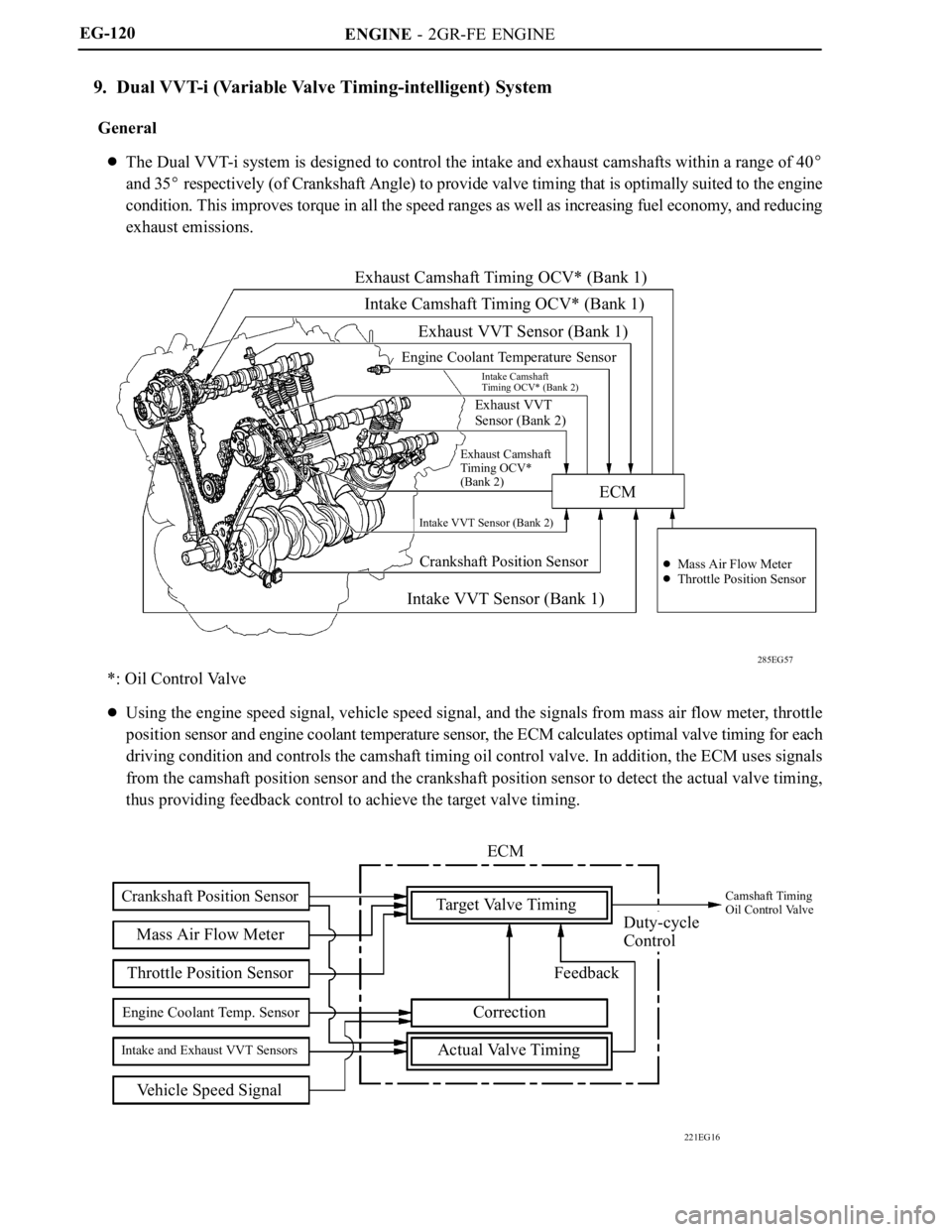Page 115 of 2000

ENGINE - 2GR-FE ENGINE
005EG13Y
: With Control
: Without Control
Ve h i c l e ’ s
Longitudinal G
Throttle Valve
Opening Angle
Accelerator Pedal
Depressed Angle
0
0
0
Time
EG-119
2) Normal Throttle Control (Non-linear Control)
The ECM controls the throttle to an optimal throttle valve angle that is appropriate for the driving
condition such as the amount of the accelerator pedal effort and the engine speed in order to realize
excellent throttle control and comfort in all operating ranges.
Control Examples during Acceleration and Deceleration
3) Idle Air Control
The ECM controls the throttle valve in order to constantly maintain an ideal idle speed.
4) TRAC Throttle Control
As part of the TRAC system, the throttle valve is closed by a demand signal from the skid control ECU
if an excessive amount of slippage is created at a driving wheel, thus facilitates the vehicle in ensuring
excellent vehicle stability and driving force.
5) VSC Coordination Control
In order to bring the effectiveness of the VSC system control into full play, the throttle valve angle is
controlled by effecting a coordination control with the skid control ECU.
6) Cruise Control
An ECM with an integrated cruise control ECU directly actuates the throttle valve for operation of the
cruise control.
Fail-safe of Accelerator Pedal Position Sensor
For details, see page 46 in 2AZ-FE engine section.
Fail-safe of Throttle Position Sensor
For details, see page 47 in 2AZ-FE engine section.
Page 116 of 2000

ENGINE - 2GR-FE ENGINE
285EG57
Exhaust Camshaft Timing OCV* (Bank 1)
Intake Camshaft Timing OCV* (Bank 1)
Exhaust VVT Sensor (Bank 1)
Engine Coolant Temperature Sensor
Intake Camshaft
Timing OCV* (Bank 2)
Exhaust VVT
Sensor (Bank 2)
Exhaust Camshaft
Timing OCV*
(Bank 2)
Intake VVT Sensor (Bank 2)
Crankshaft Position Sensor
Intake VVT Sensor (Bank 1)ECM
Mass Air Flow MeterThrottle Position Sensor
221EG16
Crankshaft Position Sensor
Mass Air Flow Meter
Throttle Position Sensor
Engine Coolant Temp. Sensor
Intake and Exhaust VVT Sensors
Vehicle Speed SignalECM
Ta r g e t Va l v e Ti m i n g
Feedback
Correction
Actual Valve Timing
Duty-cycle
Control
Camshaft Timing
Oil Control Valve
EG-120
9. Dual VVT-i (Variable Valve Timing-intelligent) System
General
The Dual VVT-i system is designed to control the intake and exhaust camshafts within a range of 40
and 35 respectively (of Crankshaft Angle) to provide valve timing that is optimally suited to the engine
condition. This improves torque in all the speed ranges as well as increasing fuel economy, and reducing
exhaust emissions.
*: Oil Control Valve
Using the engine speed signal, vehicle speed signal, and the signals from mass air flow meter, throttle
position sensor and engine coolant temperature sensor, the ECM calculates optimal valve timing for each
driving condition and controls the camshaft timing oil control valve. In addition, the ECM uses signals
from the camshaft position sensor and the crankshaft position sensor to detect the actual valve timing,
thus providing feedback control to achieve the target valve timing.
Page 117 of 2000

ENGINE - 2GR-FE ENGINE
285EG62 285EG61 285EG60
285EG63
285EG59
285EG59 285EG59
Earliest Timing
(EX)Latest Timing
(IN)TDC
EX IN
BDC
To Advance
Side (EX)To R e t a r d
Side (IN)
EX IN
To Advance
Side (IN)To R e t a r d
Side (EX)
EX IN
EX IN
EX IN
To Retard
Side (EX)To Advance
Side (IN)
To R e t a r d
Side (IN)To A d v a n c e
Side (EX)
Earliest Timing
(EX)Latest Timing
(IN)
Earliest Timing
(EX)Latest Timing
(IN)
EX IN
EX IN
EG-121
Effectiveness of the VVT-i System
Operation State
ObjectiveEffect
During Idling
Eliminating overlap to
reduce blow back to the
intake side.Stabilized idling rpm
Better fuel economy
At Light Load
Eliminating overlap to
reduce blow back to the
intake side.
Ensured engine stability
At Medium Load
Increasing overlap
increases internal EGR,
reducing pumping loss.Better fuel economy
Improved emission
control
In Low to
Medium Speed
Range with
Heavy LoadAdvancing the intake
valve close timing for
volumetric efficiency
improvement.
Improved torque in low
to medium speed range
In High Speed
Range with
Heavy LoadRetarding the intake
valve close timing for
volumetric efficiency
improvement.
Improved output
At Low
Temperatures
Eliminating overlap to
reduce blow back to the
intake side leads to the
lean burning condition,
and stabilizes the idling
speed at fast idle.
Stabilized fast idle
rpm
Better fuel economy
Upon Starting
Stopping the
Engine
Eliminating overlap to
minimize blow back to
the intake side.
Improved startability
Page 118 of 2000

ENGINE - 2GR-FE ENGINE
271EG93
Timing RotorHousingLock PinSprocket
Intake Camshaft
Vane (Fixed on Intake Camshaft)
Oil Pressure
In Operation At a Stop
Lock Pin
281EG47
Housing
Advanced Angle Assist SpringVane (Fixed on Exhaust Camshaft)Lock PinExhaust Camshaft Sprocket EG-122
Construction
1) VVT-i Controller
This controller consists of the housing driven by the timing chain and the vane coupled with the intake
and exhaust camshafts.
The intake side uses a VVT-i controller with 3 vanes, and the exhaust side uses one with 4 vanes.
When the engine stops, the intake side VVT-i controller is locked on the most retarded angle side by
the lock pin, and the exhaust side VVT-i controller is locked on the most advanced angle side. This
ensures excellent engine startability.
The oil pressure sent from the advance or retard side path at the intake and exhaust camshaft causes
rotation in the VVT-i controller vane circumferential direction to vary the intake valve timing
continuously.
An advanced angle assist spring is provided on the exhaust side VVT-i controller. This helps to apply
torque in the advanced angle direction so that the vane lock pin securely engages with the housing
when the engine stops.
Intake Side VVT-i Controller
Exhaust Side VVT-i Controller
Page 119 of 2000
ENGINE - 2GR-FE ENGINE
238EG62
To VVT-i Controller
(Advance Side) *To VVT-i Controller
(Retard Side) *
Sleeve
Spring
Drain
Oil PressureDrain
Spool ValveCoil
PlungerEG-123
2) Camshaft Timing Oil Control Valve
This camshaft timing oil control valve controls the spool valve using duty-cycle control from the ECM.
This allows hydraulic pressure to be applied to the VVT-i controller advance or retard side. When the
engine is stopped, the camshaft timing oil control valve is in the most retard position.
Intake Camshaft Timing Oil Control Valve
*: The advance and retard sides of the exhaust camshaft timing oil control valve are reverse of the intake
side.
Page 120 of 2000
ENGINE - 2GR-FE ENGINE
238EG63
Va n e
Rotational Direction
Oil Pressure
IN DrainECM
281EG48
Va n e
Rotational DirectionECM
Oil Pressure
IN Drain EG-124
Operation
1) Advance
When the camshaft timing oil control valve is positioned as illustrated below by the advance signals from
the ECM, the resultant oil pressure is applied to the timing advance side vane chamber to rotate the
camshaft in the timing advance direction.
Intake Side
Exhaust Side
Page 121 of 2000
ENGINE - 2GR-FE ENGINE
238EG64
Rotational Direction
Va n e
Drain INOil PressureECM
281EG49
Rotational Direction
Va n eECM
Drain INOil Pressure
EG-125
2) Retard
When the camshaft timing oil control valve is positioned as illustrated below by the retard signals from
the ECM, the resultant oil pressure is applied to the timing retard side vane chamber to rotate the camshaft
in the timing retard direction.
Intake Side
Exhaust Side
3) Hold
After reaching the target timing, the valve timing is held by keeping the camshaft timing oil control valve
in the neutral position unless the traveling state changes.
This adjusts the valve timing at the desired target position and prevents the engine oil from running out
when it is unnecessary.
Page 122 of 2000
ENGINE - 2GR-FE ENGINE
285EG58
Engine
Speed
ECM
ActuatorThrottle Opening Angle
Throttle Valve
Intake Air Control Valve
285EG64
Intake Air
Control Valve
Actuator EG-126
10. ACIS (Acoustic Control Induction System)
General
The ACIS consists of a bulkhead to divide the intake manifold into 2 stages, and an intake air control valve
in the bulkhead which opens and closes to vary the effective length of the intake manifold in accordance
with the engine speed and throttle valve opening angle. This increases the power output in all ranges from
low to high speed.
System Diagram
Construction
1) Intake Air Control Valve
The intake air control valve, which is
provided in the intake air chamber, opens and
closes to change the effective length of the
intake manifold in 2 stages.
2) Actuator (Motor)
The actuator activates the intake air control
valve based on signals from the ECM.